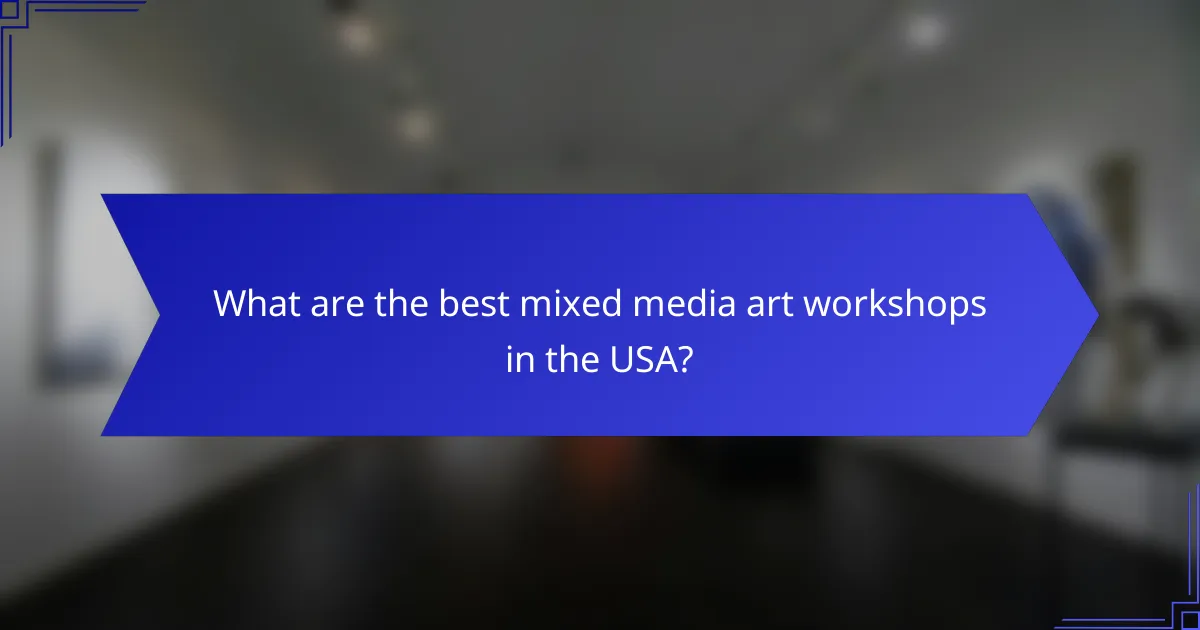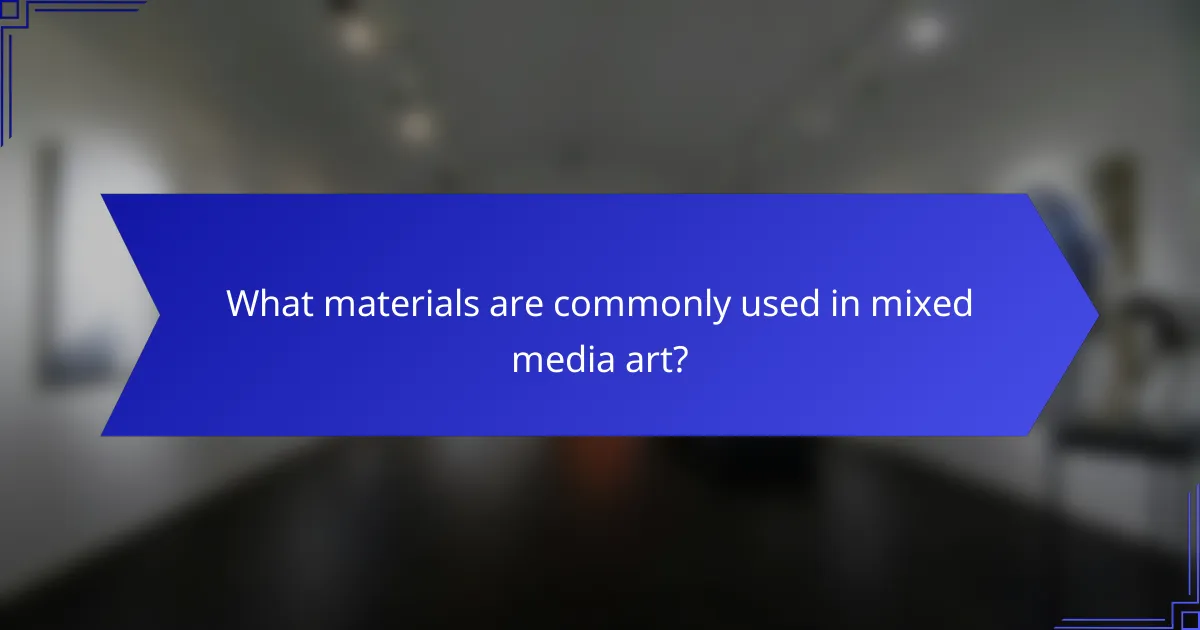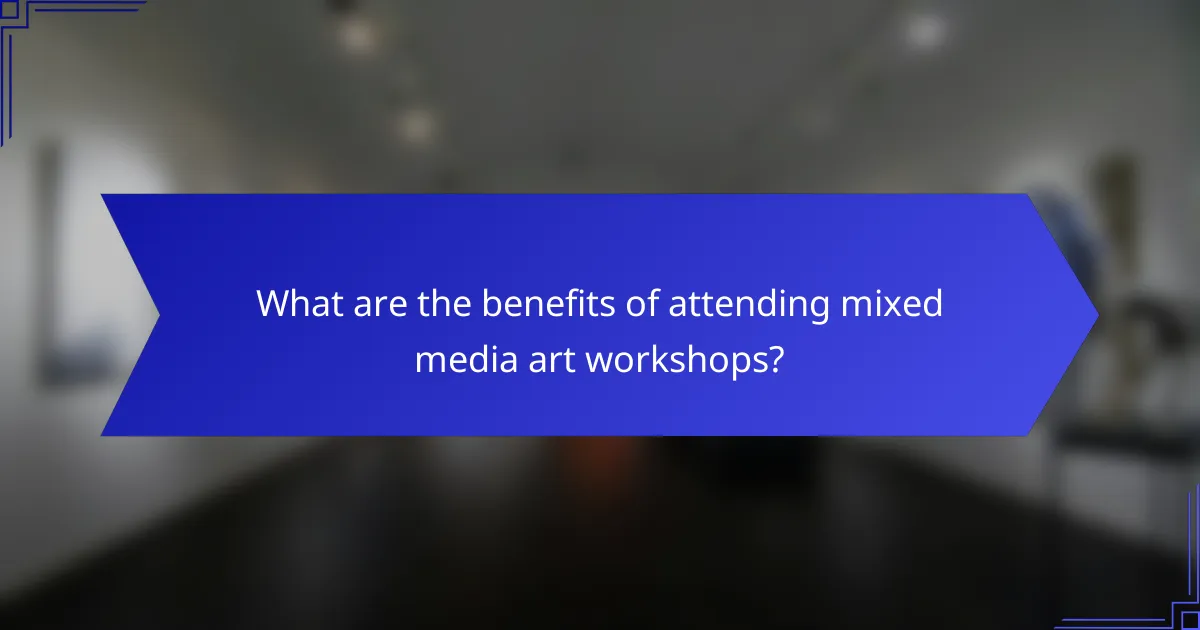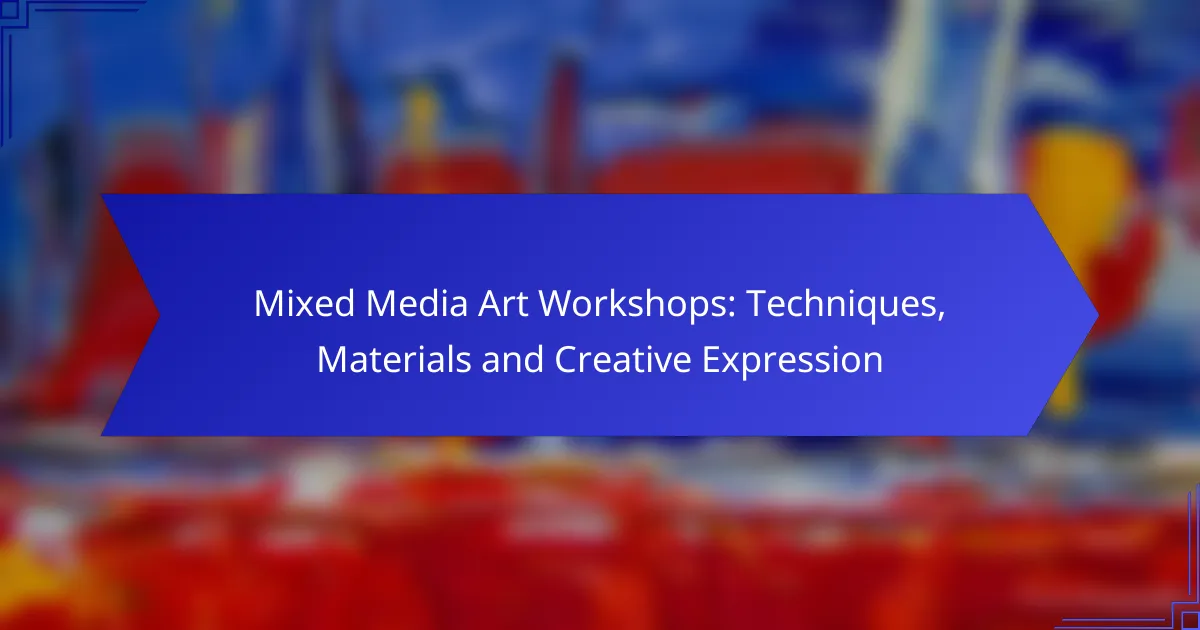Mixed media art workshops provide a unique opportunity to explore diverse techniques and materials, encouraging participants to express their creativity in innovative ways. Suitable for all skill levels, these workshops teach how to combine various mediums such as paint, paper, and fabric, resulting in distinctive artworks. When selecting a workshop, consider your experience level, the materials offered, and the instructor’s expertise to ensure a fulfilling artistic experience.

What are the best mixed media art workshops in the USA?
The best mixed media art workshops in the USA offer diverse techniques and materials, fostering creative expression among participants. These workshops vary in focus, duration, and skill level, making them accessible to both beginners and experienced artists.
Creative Arts Workshop in New Haven
The Creative Arts Workshop in New Haven provides a vibrant space for artists to explore mixed media techniques. Participants can engage in classes that cover collage, painting, and printmaking, often using recycled materials to create unique pieces.
Workshops typically run for several weeks, allowing ample time for experimentation and skill development. The supportive environment encourages collaboration and feedback among artists, enhancing the creative process.
Art Center of the Capital Region in Troy
Located in Troy, the Art Center of the Capital Region offers a variety of mixed media workshops that cater to different skill levels. Classes often include hands-on projects that combine painting, drawing, and sculptural techniques, providing a comprehensive approach to mixed media art.
Participants can expect to work with various materials, from traditional paints to unconventional items like fabric and found objects. The center emphasizes the importance of personal expression, guiding artists to develop their unique styles.
California College of the Arts in San Francisco
The California College of the Arts in San Francisco is renowned for its innovative mixed media programs. Workshops here often focus on integrating digital tools with traditional art forms, appealing to artists looking to expand their skill set.
Classes may include topics such as digital collage, interactive installations, and experimental painting techniques. The college’s resources and expert instructors provide a rich learning experience, making it an excellent choice for those serious about their artistic development.

How can I choose the right mixed media art workshop?
To choose the right mixed media art workshop, consider your skill level, the materials provided, and the credentials of the instructor. These factors will help ensure the workshop meets your creative needs and enhances your artistic journey.
Consider skill level and experience
Assessing your skill level and experience is crucial when selecting a mixed media art workshop. Beginners may benefit from workshops that focus on foundational techniques, while more advanced artists might seek sessions that explore complex methods or innovative styles.
Look for workshops that clearly state the target audience. For example, a workshop labeled “beginner-friendly” will likely provide more guidance and support, whereas an “advanced” workshop may assume prior knowledge and experience.
Evaluate materials provided
The materials included in a mixed media art workshop can significantly impact your experience. Some workshops provide all necessary supplies, while others may require participants to bring their own materials. Understanding what is included will help you prepare accordingly.
Check if the workshop covers a variety of mediums, such as acrylics, pastels, or collage materials. A diverse selection allows for greater creative expression and experimentation. Additionally, inquire about the quality of materials, as using high-quality supplies can enhance your final artwork.
Check instructor credentials
Instructor credentials play a vital role in the quality of a mixed media art workshop. Research the instructor’s background, including their education, experience, and artistic achievements. A qualified instructor can provide valuable insights and techniques that enhance your learning experience.
Look for reviews or testimonials from previous participants to gauge the instructor’s teaching style and effectiveness. A good instructor should be approachable, knowledgeable, and able to adapt to different skill levels, ensuring that all participants feel supported and engaged.

What techniques are taught in mixed media art workshops?
Mixed media art workshops typically teach a variety of techniques that combine different artistic mediums, allowing for greater creative expression. Participants learn how to blend materials like paint, paper, fabric, and found objects to create unique artworks.
Collage techniques
Collage techniques involve assembling various materials onto a single surface to create a cohesive piece. Artists often use paper, photographs, fabric, and other ephemera, layering them to achieve depth and interest. A common approach is to start with a base layer and gradually add elements, ensuring each piece complements the others.
When creating a collage, consider the balance of colors and textures. Using contrasting materials can enhance visual appeal, while a harmonious palette can create a soothing effect. Experimenting with different adhesives, such as glue sticks or gel mediums, can also affect the final look and feel of the artwork.
Painting with mixed media
Painting with mixed media combines traditional painting techniques with other materials, such as ink, pastels, or collage elements. This approach allows artists to explore various textures and effects, enriching their paintings. Techniques like layering paint over collage elements can create intriguing visual narratives.
To effectively paint with mixed media, start by applying a base layer of paint and then add other materials for contrast. Consider using transparent paints to allow underlying layers to show through, which can add complexity. Always allow sufficient drying time between layers to prevent unwanted blending.
Textural layering methods
Textural layering methods involve building up surfaces with various materials to create depth and tactile interest. Techniques may include using modeling paste, fabric, or even natural elements like sand or leaves. These layers can be painted over or left exposed to enhance the artwork’s dimensionality.
When applying textural layers, think about the visual and physical weight each material contributes. Use heavier materials at the base and lighter ones on top to maintain stability. A good practice is to test combinations on smaller pieces before committing to a larger work, ensuring the desired effect is achievable.

What materials are commonly used in mixed media art?
Mixed media art incorporates a variety of materials to create unique and expressive artworks. Commonly used materials include paints, inks, paper, canvas, found objects, and textiles, each contributing different textures and visual elements to the final piece.
Paints and inks
Paints and inks are fundamental components in mixed media art, providing color and depth. Artists often use acrylics, watercolors, and oil paints, as well as various types of inks, to achieve different effects. Consider the drying time and finish of each medium; for instance, acrylics dry quickly and can be layered, while oils take longer to dry but offer rich textures.
Experimenting with different application techniques, such as pouring, splattering, or brushing, can yield diverse results. Mixing paints with mediums like gels or pastes can also enhance texture and opacity.
Paper and canvas
Paper and canvas serve as the primary surfaces for mixed media art. Artists can choose from a range of paper types, including watercolor, cardstock, and handmade papers, each offering distinct qualities. Canvas, both stretched and un-stretched, provides a sturdy base for heavier materials.
When selecting surfaces, consider the weight and texture; heavier papers can support more layers, while textured surfaces can add visual interest. It’s advisable to use archival-quality materials to ensure longevity.
Found objects and textiles
Incorporating found objects and textiles adds dimension and personal narrative to mixed media artworks. Items like buttons, fabric scraps, and natural elements can be glued or sewn onto the surface, creating a collage effect. This approach not only enhances texture but also allows for storytelling through the materials used.
When using found objects, ensure they are clean and suitable for the intended application. Consider the weight and durability of these items, as they may require additional support or sealing to maintain their integrity over time.

What are the benefits of attending mixed media art workshops?
Attending mixed media art workshops offers numerous benefits, including enhanced creativity, community building, and practical experience with diverse materials and techniques. These workshops provide a unique environment for artists of all skill levels to explore their artistic potential and connect with others.
Enhances creative expression
Mixed media art workshops encourage participants to experiment with various materials and techniques, which can lead to greater creative expression. By combining different mediums such as paint, collage, and found objects, artists can discover new ways to convey their ideas and emotions.
For instance, a workshop may guide participants in layering paint with fabric or incorporating digital elements into traditional artwork. This exploration fosters innovation and helps artists break free from conventional boundaries.
Builds community connections
Participating in mixed media art workshops allows individuals to connect with like-minded artists and art enthusiasts. These connections can lead to lasting friendships, collaborations, and support networks that enhance the overall creative experience.
Workshops often create a welcoming atmosphere where participants can share their work, receive constructive feedback, and inspire one another. This sense of community can be particularly beneficial for those who may feel isolated in their artistic pursuits.
Provides hands-on experience
Hands-on experience is a key advantage of mixed media art workshops, as they allow participants to practice new techniques in a guided setting. Instructors often provide valuable insights and demonstrations, helping attendees gain confidence in their artistic abilities.
Workshops typically include access to a variety of materials, enabling participants to experiment without the pressure of purchasing supplies beforehand. This practical exposure can significantly enhance skills and inspire future projects.
